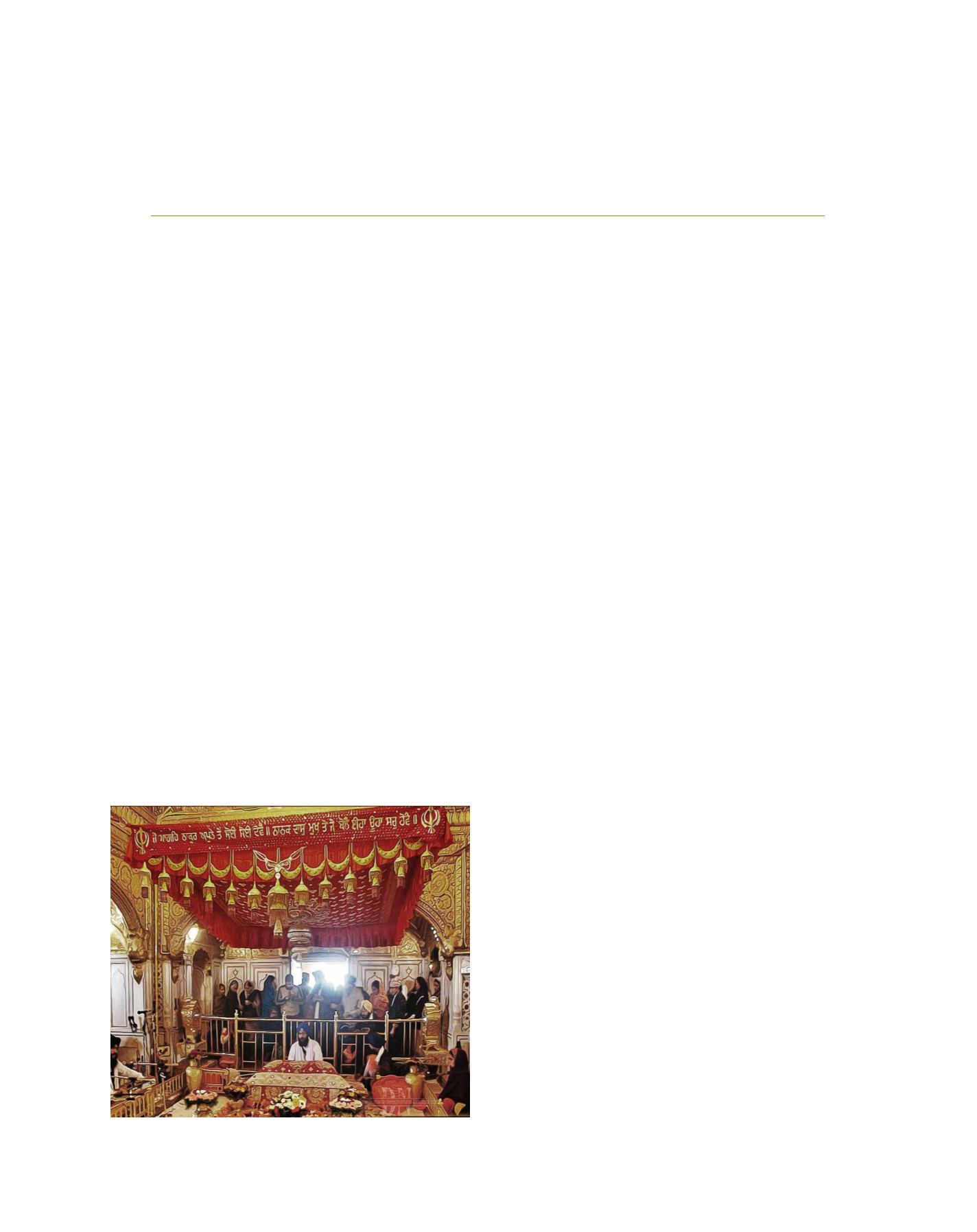

[
] 106
Gender equality and women’s empowerment
in Sikhism – the epitome of womanhood
Prabhjot Kaur, Member, and Birendra Kaur, Vice-President, Institute of Sikh Studies
T
he times of Guru Nanak (1469-1538 CE), founder
of Sikhism,
1
were fraught with social inequali-
ties of every kind, be these based on religion,
race, caste or gender. ‘Might is right’ was the law of the
land. Centuries-old social stratification was the cause of
exploitation and the degradation of man. In the midst
of such an utterly deplorable scenario, the condition
of woman was even worse, irrespective of the stratum
to which she belonged. She was at par with animals,
untouchables, and considered the lowest of the low, a
gateway to hell. Her existence was, thus, subhuman.
The Guru, however, by arousing the conscience of the
people, raised a powerful voice in her favour. In those
times of monarchy, kings were considered God-incarnate
and, like God, without any blemish. Guru Nanak reasons
in the Sikh scripture,
Guru Granth Sahib
: ‘How could
woman from whom kings are born be reviled?’
2
The Guru’s ideology of ‘one God of all humanity’ addresses
not only gender inequality, but every kind of inequality
that may be prevalent in any society. He pronounced that
‘Almighty is the Father, Almighty is the Mother; and all
human beings are God’s children’. Guru Nanak also sees
a friend/relative in God, and a husband with every devotee
denoted a woman. Reference to God with both genders, and
reference to men and women with the same gender, renders
the issue of gender inequality non-existent, a non-issue. To
him, the issue was neither man in relation to man nor man
in relation to woman, but to weave a beautiful relationship
between the All-Powerful and the person, be it he or she, or
be one from any religion, region, race or caste.
The Guru, thus, bestows equality as well as dignity to
women. A Sikh woman does not have to ask for these; they
are her birth rights. Consequently, her life changed drasti-
cally as the taboos related to her gender were now gone:
now, she was not considered impure during her menstrual
cycle or after childbirth; she began to participate in all
religious activities; she could be initiated and also initiate
others; she could be a religious head; she was not to wear
a veil to cover her face; families that indulged in female
infanticide were to be socially boycotted; child marriage
and dowry were prohibited; widows could remarry.
The Guru created an environment where women could
live a life free from any indignities. They recognized as
real all feminine urges and emotions. Household duties
performed by women were not considered insignificant.
Rather, caring for the family, performed so naturally and
lovingly by women, is seen as godlike. Spiritual flavour is
lent to these activities by comparing the love of a mother for
her child to the love of God for His creation.
The nine succeeding Gurus further provided equal oppor-
tunities of education, training in martial arts, religious and
political leadership roles, and endowed responsibilities
and duties on women. Women thus involved themselves
wholeheartedly in the making of a new social order. This
journey started with Mata Khivi, wife of the second Guru,
Guru Angad Dev (1504-1552), who became the first
administrative head of the Guru’s free communal kitchen,
langar
, and helped establish it as a permanent institution in
Sikhism. Years later, when the third Guru, Guru Amar Das
(1479-1574), gave structure to the Sikh
panth
(nation) and
organized his preachers into 22 teaching districts or
manjis
(literal translation: type of seat), he put Bibi Amro, daughter
of the second Guru, in charge of one of these districts. As
the Guru’s representative, she also had the responsibility of
collecting revenues and making decisions for the welfare of
her diocese. By the time of the tenth Guru, Guru Gobind
Singh (1666-1708), women were even confident enough
to fight in the battlefield alongside men if needed. Women
would also nurse the wounded in the battlefield, and under-
take daring activities. Mata Sundri, the tenth Guru’s wife,
Image: www. PunjabiTurban.com
Men and women worshipping inside Harmandir Sahib (the Golden Temple)
A B
etter
W
orld
















